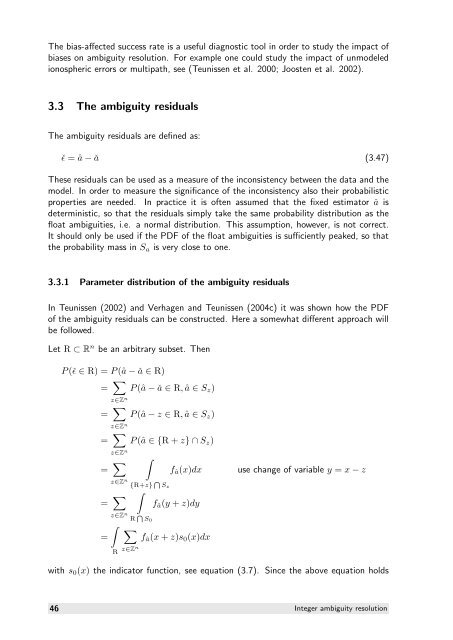The GNSS integer ambiguities: estimation and validation
The GNSS integer ambiguities: estimation and validation
The GNSS integer ambiguities: estimation and validation
You also want an ePaper? Increase the reach of your titles
YUMPU automatically turns print PDFs into web optimized ePapers that Google loves.
<strong>The</strong> bias-affected success rate is a useful diagnostic tool in order to study the impact of<br />
biases on ambiguity resolution. For example one could study the impact of unmodeled<br />
ionospheric errors or multipath, see (Teunissen et al. 2000; Joosten et al. 2002).<br />
3.3 <strong>The</strong> ambiguity residuals<br />
<strong>The</strong> ambiguity residuals are defined as:<br />
ˇɛ = â − ǎ (3.47)<br />
<strong>The</strong>se residuals can be used as a measure of the inconsistency between the data <strong>and</strong> the<br />
model. In order to measure the significance of the inconsistency also their probabilistic<br />
properties are needed. In practice it is often assumed that the fixed estimator ǎ is<br />
deterministic, so that the residuals simply take the same probability distribution as the<br />
float <strong>ambiguities</strong>, i.e. a normal distribution. This assumption, however, is not correct.<br />
It should only be used if the PDF of the float <strong>ambiguities</strong> is sufficiently peaked, so that<br />
the probability mass in Sa is very close to one.<br />
3.3.1 Parameter distribution of the ambiguity residuals<br />
In Teunissen (2002) <strong>and</strong> Verhagen <strong>and</strong> Teunissen (2004c) it was shown how the PDF<br />
of the ambiguity residuals can be constructed. Here a somewhat different approach will<br />
be followed.<br />
Let R ⊂ R n be an arbitrary subset. <strong>The</strong>n<br />
P (ˇɛ ∈ R) = P (â − ǎ ∈ R)<br />
= <br />
P (â − ǎ ∈ R, â ∈ Sz)<br />
z∈Z n<br />
= <br />
P (â − z ∈ R, â ∈ Sz)<br />
z∈Z n<br />
= <br />
P (â ∈ {R + z} ∩ Sz)<br />
z∈Z n<br />
= <br />
<br />
z∈Zn {R+z} T Sz<br />
= <br />
<br />
=<br />
<br />
z∈Zn R T S0<br />
R<br />
z∈Zn fâ(x)dx use change of variable y = x − z<br />
fâ(y + z)dy<br />
<br />
fâ(x + z)s0(x)dx<br />
with s0(x) the indicator function, see equation (3.7). Since the above equation holds<br />
46 Integer ambiguity resolution
















